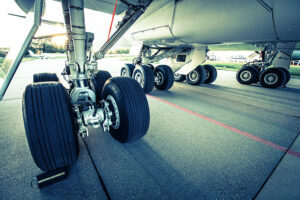On This Page
Learn Why the Smallest Component of a Plane Is One of the Most Important | Aerospace components manufacturers
For some people, flying on a plane is as easy as riding in a car. For others, planes cause extra anxiety. If you’re someone that feels uneasy while flying, you probably worry about the numerous systems and parts that have to work to get you safely to your destination. So many details go into every system of a plane, and aerospace components manufacturers are responsible for ensuring a safe and efficient flight. When you think about the most important systems of a plane, you probably think of the engine, cabin pressure, and landing gear. Out of the 3 systems, landing gear may seem like the smallest part, but safe landings would not be possible without this gear. We’ll leave the complicated terms to the engineers, but if you’d like to learn more about landing gear designed by aerospace components manufacturers, keep reading.What is Landing Gear?
 Landing gear is one of the subsystems of a plane, also known as the undercarriage, that is responsible for smooth and safe departures and landings. The landing gear system as a whole includes structural members, hydraulics, energy absorption, brakes, and wheels. Retracting mechanisms and steering components are also necessary to deploy the landing gear while also guiding the plane on the runway. Landing gear is designed to support a plane’s maximum capacity and weight, including passengers, cargo, and a full tank of gas.
Many aerospace components manufacturers have faced issues while designing landing gear. Ideally, the landing gear itself should be the lightest weight it can be, have minimum volume, and low life cycle cost. It’s an ongoing process to design the lightest and most efficient landing gear, but new theories are being tested every day. No matter the type of landing gear, aerospace components manufacturers design it to provide a suspension system during taxing on the runway, take-off, and landing. The landing gear should absorb and disperse the kinetic energy during the intense landing sequence.
Other than the very important job of helping the plane land, landing gear acts like brakes for the plane. When the wheel braking system is activated, the landing gear also provides directional control on the ground. And as many people will hear, the landing gear retracts after take-off and deploys before landing. Aerospace components manufacturers design landing gear to retract back into the plane to minimize the aerodynamic drag on the plane when it’s in the air.
Landing gear is one of the subsystems of a plane, also known as the undercarriage, that is responsible for smooth and safe departures and landings. The landing gear system as a whole includes structural members, hydraulics, energy absorption, brakes, and wheels. Retracting mechanisms and steering components are also necessary to deploy the landing gear while also guiding the plane on the runway. Landing gear is designed to support a plane’s maximum capacity and weight, including passengers, cargo, and a full tank of gas.
Many aerospace components manufacturers have faced issues while designing landing gear. Ideally, the landing gear itself should be the lightest weight it can be, have minimum volume, and low life cycle cost. It’s an ongoing process to design the lightest and most efficient landing gear, but new theories are being tested every day. No matter the type of landing gear, aerospace components manufacturers design it to provide a suspension system during taxing on the runway, take-off, and landing. The landing gear should absorb and disperse the kinetic energy during the intense landing sequence.
Other than the very important job of helping the plane land, landing gear acts like brakes for the plane. When the wheel braking system is activated, the landing gear also provides directional control on the ground. And as many people will hear, the landing gear retracts after take-off and deploys before landing. Aerospace components manufacturers design landing gear to retract back into the plane to minimize the aerodynamic drag on the plane when it’s in the air.
The 9 Steps of Landing Gear Design and Development
For a complicated aerospace system, there’s a complicated design process included. Landing gear must go through multiple different tests to be deemed safe for the aircraft. Below you can find a preview for each of the 9 steps.- Concept Design – Begins with the study of all the design specifications and air regulations.
- Preliminary Design – Dynamic simulations are created for departure and landing.
- Detailed Design – The detailed design of all of the landing gear components is performed including component loads, material selection, and sizing.
- Stress & Fatigue Analysis – A low cycle, high-stress fatigue analysis is tested for the landing gear life evaluation.
- Reliability & Maintainability Analysis – Failure Mode and Effect and Critical Analysis (FMECA) is performed.
- Manufacturing & Assembly – Landing gear components are made of ultra-high-strength steels, titanium, and aluminum alloys.
- Qualification Testing – Involves functional tests, structural tests for strength, stiffness, and environmental tests.
- On-Aircraft Testing – The final integration step of the landing gear into the aircraft. Followed by taxi, brake, and steering tests.
- In-service Evaluation – Evaluations performed in different types of airfield conditions.

 Ready for Take-Off
Ready for Take-Off